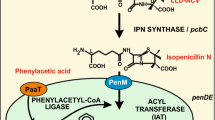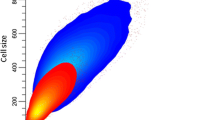Abstract
Protoplasts of the basidiomycete, Fomitopsis palustris (formerly Tyromyces palustris), were utilized to study a function of the fungal plasma membrane. Fungal protoplasts exhibited metabolic activities as seen with intact mycelial cells. Furthermore, the uptake of certain compounds into the protoplast cells was quantitatively observed by using non-radioactive compounds. Vanillin was converted to vanillyl alcohol and vanillic acid as major products and to protocatechuic acid and 1,2,4-trihydroxybenzene as trace products by protoplasts prepared from F. palustris. Extracellular culture medium showed no activity responsible for the redox reactions of vanillin. Only vanillic acid was detected in the intracellular fraction of protoplasts. However, the addition of disulfiram, an aldehyde dehydrogenase inhibitor, caused an intracellular accumulation of vanillin, strongly suggesting that vanillin is taken up by the cell, followed by oxidation to vanillic acid. The addition of carbonylcyanide m-chlorophenylhydrazone, which dissipates the pH gradient across the plasma membrane, inhibited the uptake of either vanillin or vanillic acid into the cell. Thus, the fungus seems to possess transporter devices for both vanillin and vanillic acid for their uptake. Since vanillyl alcohol was only observed extracellularly, the reduction of vanillin was thought to be catalyzed by a membrane system.



Similar content being viewed by others
References
Allende JL, Suarez M, Gallego M, Petrierra AG (1993) 4-Hydroxybenzoate uptake in Klebsiella pneumoniae is driven by electrical potential. Arch Biochem Biophys 300:142–147
Ander P, Hatakka A, Eriksson KE (1980) Vanillic acid metabolism by the white-rot fungus Sporotrichum pulverulentum. Arch Microbiol 125:189–202
Bavendamm W (1928) Üder das Vorkommen und den Nachweis von Oxydasen bei Holzzerstörenden Pilzen. Z Pflanzenkrankh Pflanzenschutz 38:257–276
Bennett AF, Buckley PD, Blackwell LF (1982) Proton release during the pre-steady-state oxidation of aldehyde by aldehyde dehydrogenase. Evidence for a rate-limiting conformational change. Biochemistry 21:4407–4413
Buswell JA, Eriksson KE, Gupta JK, Hamp SG, Nordh I (1982) Vanillic acid metabolism by selected soft-rot, brown-rot, and white-rot fungi. Arch Microbiol 131:366–374
Chen S, Halkier BA (2001) Characterization of glucosinolate uptake by leaf protoplasts of Brassica napus. J Biol Chem 275:22955–22960
Crawford RL (1981) Lignin biodegradation and transformation. Wiley, New York
D’Argenio DA, Segura A, Coco WM, Bunz PV, Ornston LN (1999) The physiological contribution of Acinetobacter PcaK, a transport system that acts upon protocatechuate, can be masked by the overlapping specificity of VanK. J Bacteriol 181:3505–3515
Eguchi F, Tashiro M, Suzuki T, Higaki M (1990) Preparation and regeneration of protoplasts of edible mushrooms. Mokuzai Gakkaishi 36:232–240
Greene RV, Gould JM (1984) Electrogenic symport of glucose and protons in membrane vesicles of Phanerochaete chrysosporium. Arch Biochem Biophys 228:97–104
Harwood CS, Gibson J (1986) Uptake of benzoate by Rhodopseudomonas palustris grown anaerobically in light. J Bacteriol 165:504–509
Heipieper HJ, Diefenbch R, Keweloh H (1992) Conversion of cis unsaturated fatty acids to trans: a possible mechanism for the protection of phenol-degrading Pseudomonas putida P8 from substrate toxicity. Appl Environ Microbiol 58:1847–1852
Jensen KA, Houtman CJ, Ryan ZC, Hammel KE (2001) Pathways for extracellular fenton chemistry in the brown rot basidiomycete Gloephyllum trabeum. Appl Environ Microbiol 67:2705–2711
Kamada F, Abe S, Hiratsuka N, Wariishi H, Tanaka H (2002) Mineralization of aromatic compounds by the brown-rot basidiomycetes: mechanisms involved in the initial attack on aromatic ring. Microbiology 148:1939–1946
Kerem Z, Bao W, Hammel KE (1998) Rapid polyether cleavage via extracellular one-electron oxidation by a brown rot basidiomycete. Proc Natl Acad Sci USA 95:10373–10377
Kirk TK, Kelman A (1965) Lignin degradation as related to the phenoloxidases of selected wood-decaying basidiomycetes. Phytopathology 55:739–745
Lapadatescu C, Ginies C, Le Quere JL, Bonnarme P (2000) Novel scheme for biosynthesis of aryl metabolites from l-phenylalanine in the fungus Bjerkandera adusta. Appl Environ Microbiol 67:1517–1522
Merkel SM, Eberhard AE, Gibson J, Harwood CS (1989) Involvement of coenzyme A thioesters in anaerobic metabolism of 4-hydroxybenzoate by Rhodopseudomonas palustris. J Bacteriol 171:1–7
Nichols NN, Harwood CS (1997) PcaK, a high-affinity permease for the aromatic compounds 4-hydroxybenzoate and protocatechuate from Pseudomonas putida. J Bacteriol 179:5056–5061
Camp RG op den, Kuhlemeier C (1997) Aldehyde dehydrogenase in tabacco pollen. Plant Mol Biol 35:355–365
Petersen EN (1992) The pharmacology and toxicology of disulfiram and its metabolites. Acta Psychiatr Scand Suppl 369:7–13
Rieble S, Joshi D, Gold MH (1994) Purification and characterization of a 1, 2, 4-trihydroxybenzene 1, 2-dioxygenase from the basidiomycete Phanerochaete chrysosporium. J Bacteriol 176:4838–4844
Saito M, Rosenberg A (1985) Influence of monovalent cation transport on anabolism of glycosphingolipids in cultured human fibroblast. Biochemistry 24:3054–3059
Tai D, Terazawa M, Chen CL, Chang H (1990) Lignin biodegradation products from birch wood decayed by Phanerochaete chrysosporium: part 2. The constituents of ether-soluble low-molecular-weight fraction. Holzforschung 44:257–262
Vanice GF, Boyd SA, Mokuma DL (1985) Extraction of phenolic compounds from a spodosol profile: an evaluation of three extractants. Soil Sci 140:412–420
Varela E, Martinez MJ, Martinez AT (2000) Aryl-alcohol oxidase protein sequence: a comparison with glucose oxidase and other FAD oxidoreductases. Biochim Biophys Acta 1481:202–208
Whitehead DC (1964) Identification of p-hydroxybenzoic, vanillic, p-coumaric and felulic acids in soils. Nature 202:417–418
Whitehead DC, Dibb H, Hartley RD (1981) Extraction pH and the release of phenolic compounds from soils, plant roots and leaf litter. Soil Biol Biochem 13:343–348
Whitehead DC, Dibb H, Hartley RD (1982) Phenolic compounds in soil as influenced by the growth of different plant species. J Appl Ecol 19:579–588
Yajima Y, Enoki A, Mayfield MB, Gold MH (1979) Vanillate hydroxylase from white rot basidiomycete Phanerochaete chrysosporium. Arch Microbiol 123:319–321
Acknowledgements
This research was supported by a Grant-in-Aid for Scientific Research from the Japan Science Promotion Society (15380224) and by the Science and Technology Incubation Program in Advanced Regions from the Japan Science and Technology Corporation (H.W.).
Author information
Authors and Affiliations
Corresponding author
Rights and permissions
About this article
Cite this article
Shimizu, M., Kobayashi, Y., Tanaka, H. et al. Transportation mechanism for vanillin uptake through fungal plasma membrane. Appl Microbiol Biotechnol 68, 673–679 (2005). https://doi.org/10.1007/s00253-005-1933-2
Received:
Revised:
Accepted:
Published:
Issue Date:
DOI: https://doi.org/10.1007/s00253-005-1933-2




